Mineralogy, Geochemistry, and Age Constraints on the Axinite-Bearing Gukjeon Pb–Zn Skarn Deposit in the Miryang Area, South Korea
Abstract
1. Introduction
2. Regional Geology
3. Local Geology
3.1. Miryang Andesite
3.2. Jeonggaksan Formation
3.3. Beomdori Andesite
3.4. Dacite
3.5. Eonyang Granite (Bulguksa Intrusives)
4. Methodology
5. Alteration
5.1. Pre-Skarn Alteration
5.2. Skarn Alteration
5.2.1. Pyroxene
5.2.2. Garnet
5.2.3. Amphibole
5.2.4. Axinite
5.2.5. Epidote
5.3. Post-Skarn Alteration
6. Skarn Mineralization
6.1. Orebody Geometry
6.2. Mineralization
7. Geochemistry
7.1. Major and Trace Elements
7.2. Boron, Lead, and Zinc Geochemistry
8. Zircon SHRIMP U-Pb Geochronology
9. Discussion and Conclusions
Supplementary Materials
Author Contributions
Funding
Data Availability Statement
Acknowledgments
Conflicts of Interest
References
- Kim, T. Technical Report of Gukjeon Mine. KORES Report; KORES: Wonju, Korea, 1999; p. 10. (In Korean) [Google Scholar]
- Kang, H. Korea Resources Corporation. Reports on Drilling Results of Gukjeon Pb-Zn Mine; KORES: Wonju, Korea, 2009; p. 13. (In Korean) [Google Scholar]
- Choi, D.; Hwang, H.; Oh, G.; Jeong, D. KORES. Report on Detailed Survey Result (Mo: Sangju Area) (Zn-Pb: Samcheok and Miryang area) (Cu: Jeongsun Area), DS2012-MT(III), (IV), (V); KORES: Wonju, Korea, 2012; p. 80. (In Korean) [Google Scholar]
- Sung, J. Report on 2013 Drilling Results of Gukjeon Pb-Zn Mine. KORES Report; KORES: Wonju, Korea, 2014; p. 19. (In Korean) [Google Scholar]
- Yang, C.; Choi, J.B. Occurrence of the Pb-Zn Skarn Deposits in Gukjeon Mine, Korea. J. Mineral. Soc. Korea 2010, 23, 413–428, (In Korean with English Abstract). [Google Scholar]
- Kwak, J.Y.; Kang, C.W.; Joo, S.Y.; Jeong, J.H.; Choi, J.B. Occurence of Zn-Pb Deposits in Danjang-Myeon, Milyang Area. J. Mineral. Soc. Korea 2015, 28, 279–292. [Google Scholar] [CrossRef]
- Ryu, I.-C.; Choi, S.-G.; Wee, S.-M. An Inquiry into the Formation and Deformationof the Cretaceous Gyeongsang (Kyongsang) Basin, Southeastern Korea. Econ. Environ. Geol. 2006, 39, 129–149, (In Korean with English Abstract). [Google Scholar]
- Koh, S.-M.; Ryoo, C.-R.; Song, M.-S. Mineralization Characteristics and Structural Controls of Hydrothermal Deposits in the Gyeongsang Basin, South Korea. Resour. Geol. 2003, 53, 175–192. [Google Scholar] [CrossRef]
- Chae, U.; Kim, G.; Hong, S.; Lee, B.; Hwang, J.; Park, K.; Hwang, S.; Choi, B.; Song, G.; Jin, M. Geological Map of Korea (1:1,000,000). Korea Institute of Geolgoy, Mining and Materials, 1995; (In Korean with English Abstract).
- Kim, K.B.; Hwang, S.K. Geological Report of The Miryang Sheet (SCALE 1:50,000); Korea Institute of Energy and Resources: Seoul, Korea, 1988; (In Korean with English Abstract). [Google Scholar]
- Hong, S.H.; Choi, P. Geological Report of the Yucheon Sheet; Korea Institute of Energy and Resources: Seoul, Korea, 1988; (In Korean with English Abstract). [Google Scholar]
- Takagi, T.; Koh, S.; Kim, M.; Naito, K.; Sudo, S. Geology and Hydrothermal Alteration of the Milyang Pyrophyllite Deposit, Southeast Korea. Resour. Geol. 2000, 50, 243–256. [Google Scholar] [CrossRef]
- Koh, S.-M.; Takagi, T.; Kim, M.; Naito, K.; Hong, S.; Sudo, S. Geological and Geochemical Characteristics of the Hydrothermal Clay Alteration in South Korea. Resour. Geol. 2000, 50, 229–242. [Google Scholar] [CrossRef]
- Paces, J.B.; Miller, J.D., Jr. Precise U–Pb ages of Duluth Complex and related mafic intrusions, Northeastern Minnesota: Geochronological insights to physical, petrogenic, paleomagnetic, and tectonomagmatic processes associated with the 1.1 Ga midcontinent rift system. J. Geophys. Res. 1993, 98, 13997–14013. [Google Scholar] [CrossRef]
- Williams, I.S. U-Th-Pb geochronology by ion microprobe. In Applications of Microanalytical Techniques to Understanding Mineralizing Processes; Reviews in Economic Geology; McKibben, M.A., Shanks, W.C., III, Rindley, W.I., Eds.; Society of Economic Geologists: Littleton, CO, USA, 1998; Volume 7, pp. 1–35. [Google Scholar]
- Ludwig, K.R. User’s Manual for Isoplot 3.7 A Geochronological Toolkit for Microsoft Excel; Berkeley Geochronological Center: Berkeley, ON, Canada, 2008. [Google Scholar]
- Morimoto, N. Nomenclature of Pyroxenes. Mineral. Petrol. 1988, 39, 55–76. [Google Scholar] [CrossRef]
- Mange, M.A.; Morton, A.C. Chapter 13 Geochemistry of Heavy Minerals. In Developments in Sedimentology; Elsevier: Amsterdam, The Netherlands, 2007; Volume 58, pp. 345–391. ISBN 9780444517531. [Google Scholar]
- Leake, B.E.; Woolley, A.R.; Arps, C.E.S.; Birch, W.D.; Gilbert, M.C.; Grice, J.D.; Hawthorne, F.C.; Kato, A.; Kisch, H.J.; Krivovichev, V.G.; et al. Nomenclature of amphiboles: Report of the subcommittee on amphiboles of the international mineralogical association, commission on new minerals and mineral names. Can. Mineral. 1997, 35, 219–246. [Google Scholar]
- Filip, J.; Dachs, E.; Tucek, J.; Novak, M.; Bezdicka, P. Low-temperature calorimetric and magnetic data for natural end-members of the axinite group. Am. Mineral. 2008, 93, 548–557. [Google Scholar] [CrossRef]
- Franz, G.; Liebscher, A. Physical and Chemical Properties of the Epidote Minerals – An Introduction. Rev. Mineral. Geochem. 2004, 56, 1–82. [Google Scholar] [CrossRef]
- Barton, P.B.J. Some Ore Textures Involving Sphalerite from the Furutobe Mine, Akita Prefecture, Japan. Min. Geol. 1978, 28, 293–300. [Google Scholar] [CrossRef]
- Cox, K.G.; Bell, J.D.; Pankhurst, R.J. The Interpretation of Igneous Rocks; Springer Netherlands: Dordrecht, The Netherlands, 1979; ISBN 978-0-412-53410-2. [Google Scholar]
- Peccerillo, A.; Taylor, S.R. Geochemistry of Eocene calc-alkaline volcanic rocks from the Kastamonu area, Northern Turkey. Contrib. to Mineral. Petrol. 1976, 58, 63–81. [Google Scholar] [CrossRef]
- McDonough, W.F.; Sun, S.S. The composition of the Earth. Chem. Geol. 1995, 120, 223–253. [Google Scholar] [CrossRef]
- Pearce, J.A.; Harris, N.B.W.; Tindle, A.G. Trace Element Discrimination Diagrams for the Tectonic Interpretation of Granitic Rocks. J. Petrol. 1984, 25, 956–983. [Google Scholar] [CrossRef]
- Pichavant, M.; Manning, D. Petrogenesis of tourmaline granites and topaz granites; the contribution of experimental data. Phys. Earth Planet. Inter. 1984, 35, 31–50. [Google Scholar] [CrossRef]
- Qiu, Y.; Zhang, R.; Chou, I.-M.; Wang, X.; Hu, W.; Zhang, W.; Lu, J.; Li, G.; Li, Z. Boron-rich ore-forming fluids in hydrothermal W-Sn deposits from South China: Insights from in situ Raman spectroscopic characterization of fluid inclusions. Ore Geol. Rev. 2021, 132, 104048. [Google Scholar] [CrossRef]
- Zhang, Y.B.; Zhai, M.; Hou, Q.L.; Li, T.S.; Liu, F.; Hu, B. Late Cretaceous volcanic rocks and associated granites in Gyeongsang Basin, SE Korea: Their chronological ages and tectonic implications for cratonic destruction of the North China Craton. J. Asian Earth Sci. 2012, 47, 252–264. [Google Scholar] [CrossRef]
- Thomas, R.; Heinrich, W.; Förster, H.J. The behaviour of boron in peraluminous granite-pegmatite systems and associated hydrothermal solutions: A melt and fluid inclusion study. Contrib. Mineral. Petrol. 2003, 144, 457–472. [Google Scholar] [CrossRef]
- Bortnikov, N.S.; Genkin, A.D.; Dobrovol’skaya, M.G.; Muravitskaya, G.N.; Filimonova, A.A. The nature of chalcopyrite inclusions in sphalerite; exsolution, coprecipitation, or “Disease”? Econ. Geol. 1992, 87, 1192–1193. [Google Scholar] [CrossRef]
- Kojima, S. A Coprecipitation experiment on intimate association of sphalerite and chalcopyrite and its bearings on the genesis of Kuroko ores. Min. Geol. 1990, 40, 147–158. [Google Scholar]
- Kojima, S.; Nagase, T.; Inoue, T. A coprecipitation experiment on the chalcopyrite disease texture involving Fe-bearing sphalerite. J. Mineral. Petrol. Econ. Geol. 1995, 90, 261–267. [Google Scholar] [CrossRef][Green Version]
- Hwang, S.K.; Kim, S.W.; Kim, S.; Ahn, U.S.; Jo, I.H.; Lee, S.J.; Kim, J.J. Chronostratigraphic implication of the Yucheon Group in Gyeongsang basin, Korea. J. Geol. Soc. Korea 2019, 55, 633–647, (In Korean with English Abstract). [Google Scholar] [CrossRef]
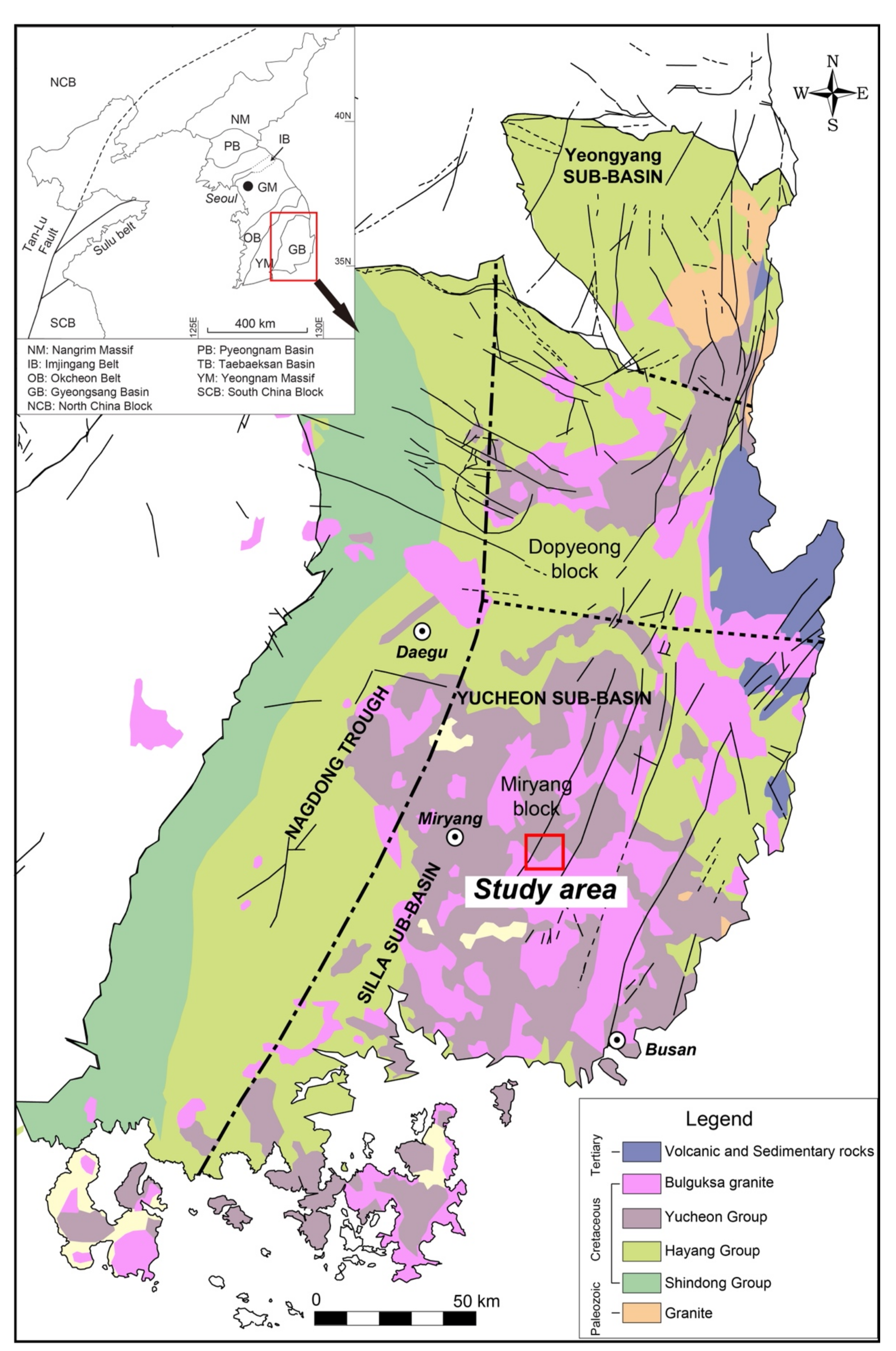
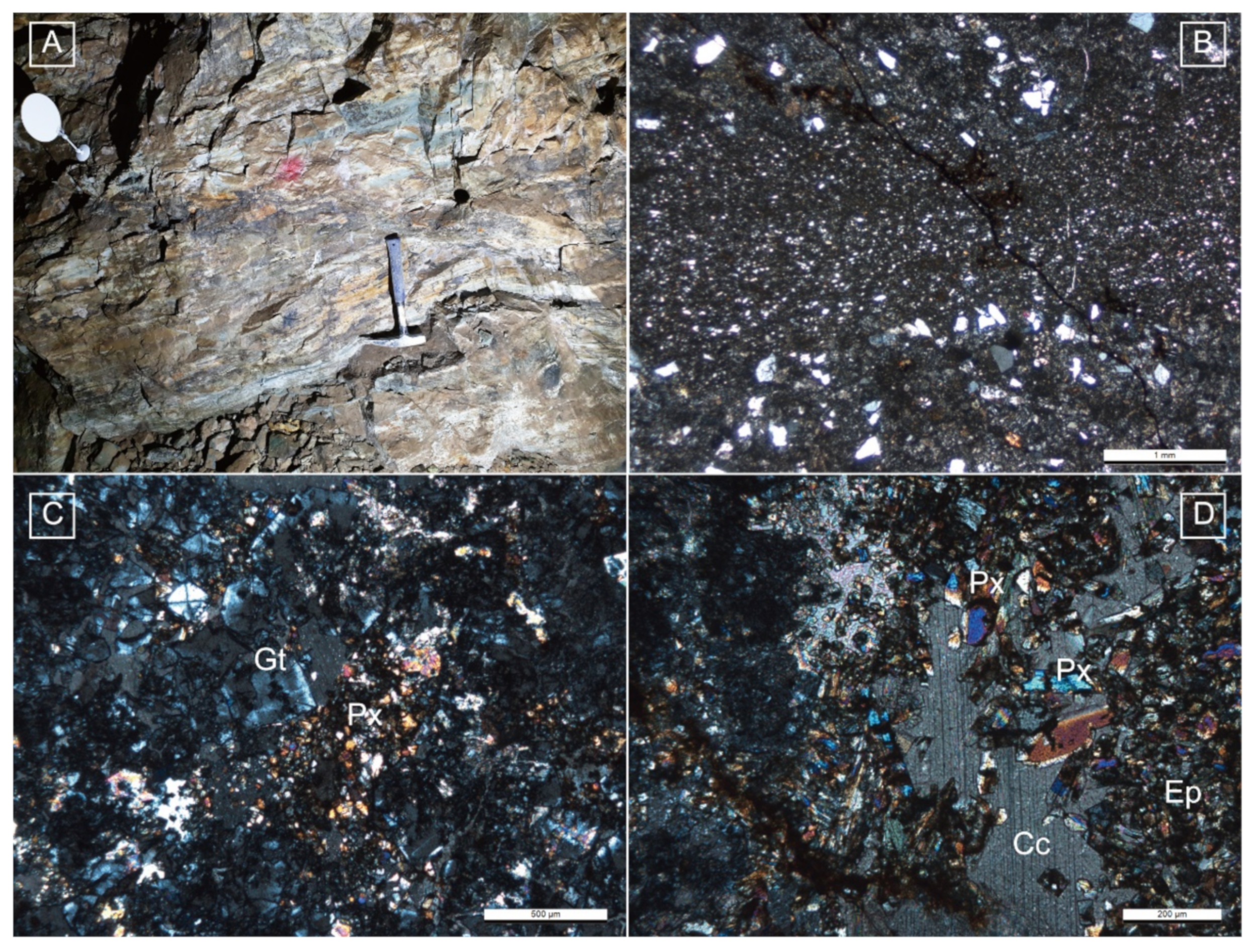

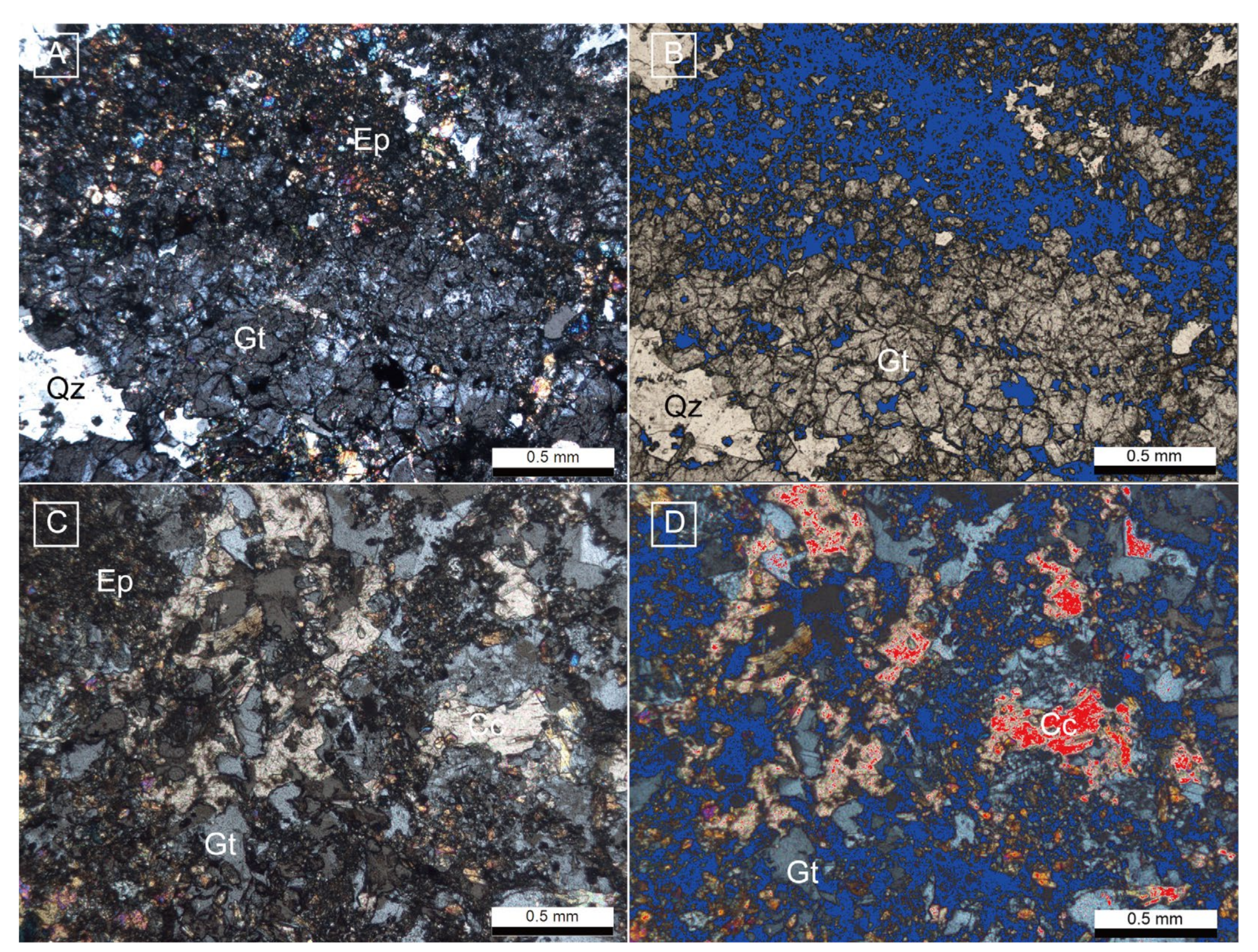



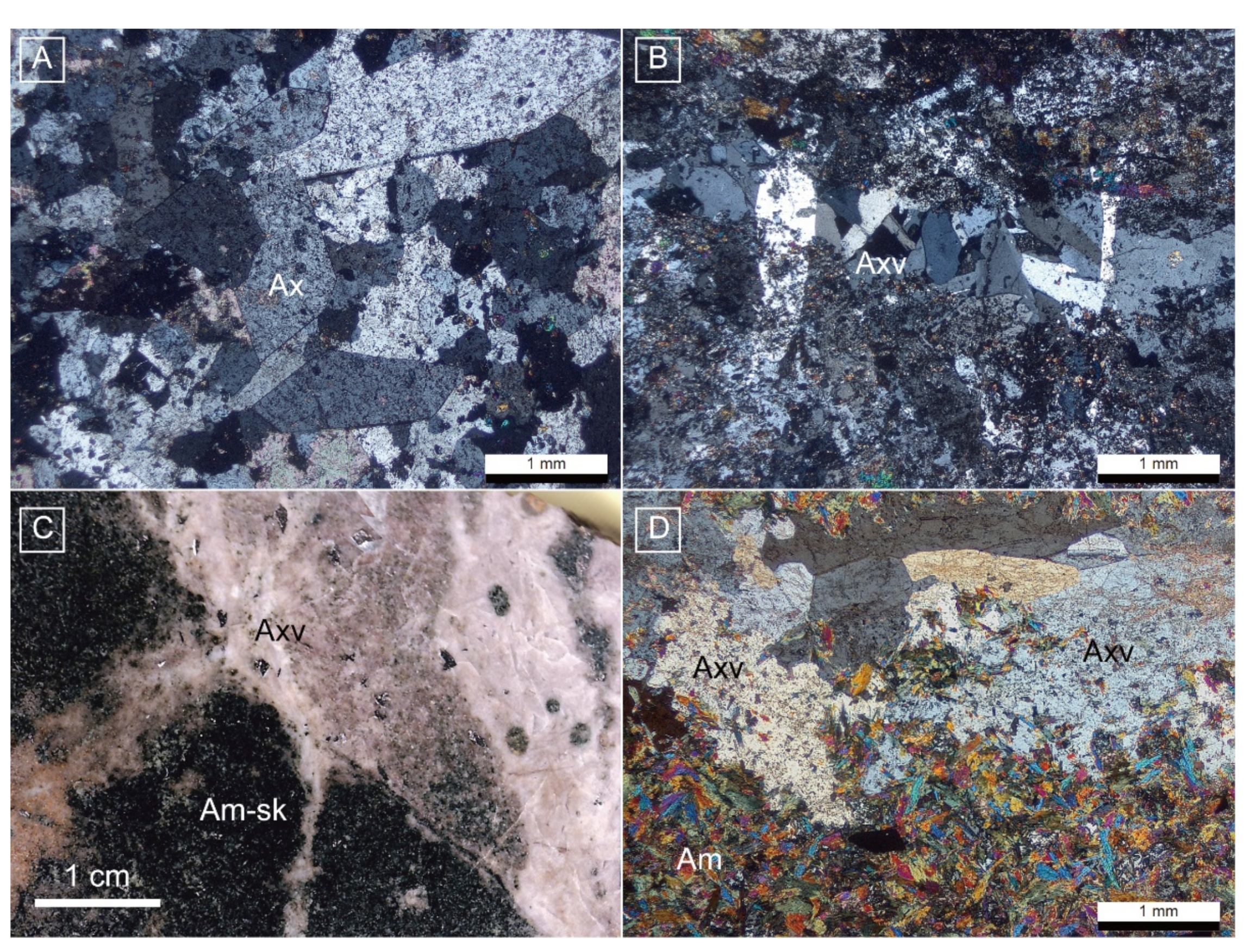
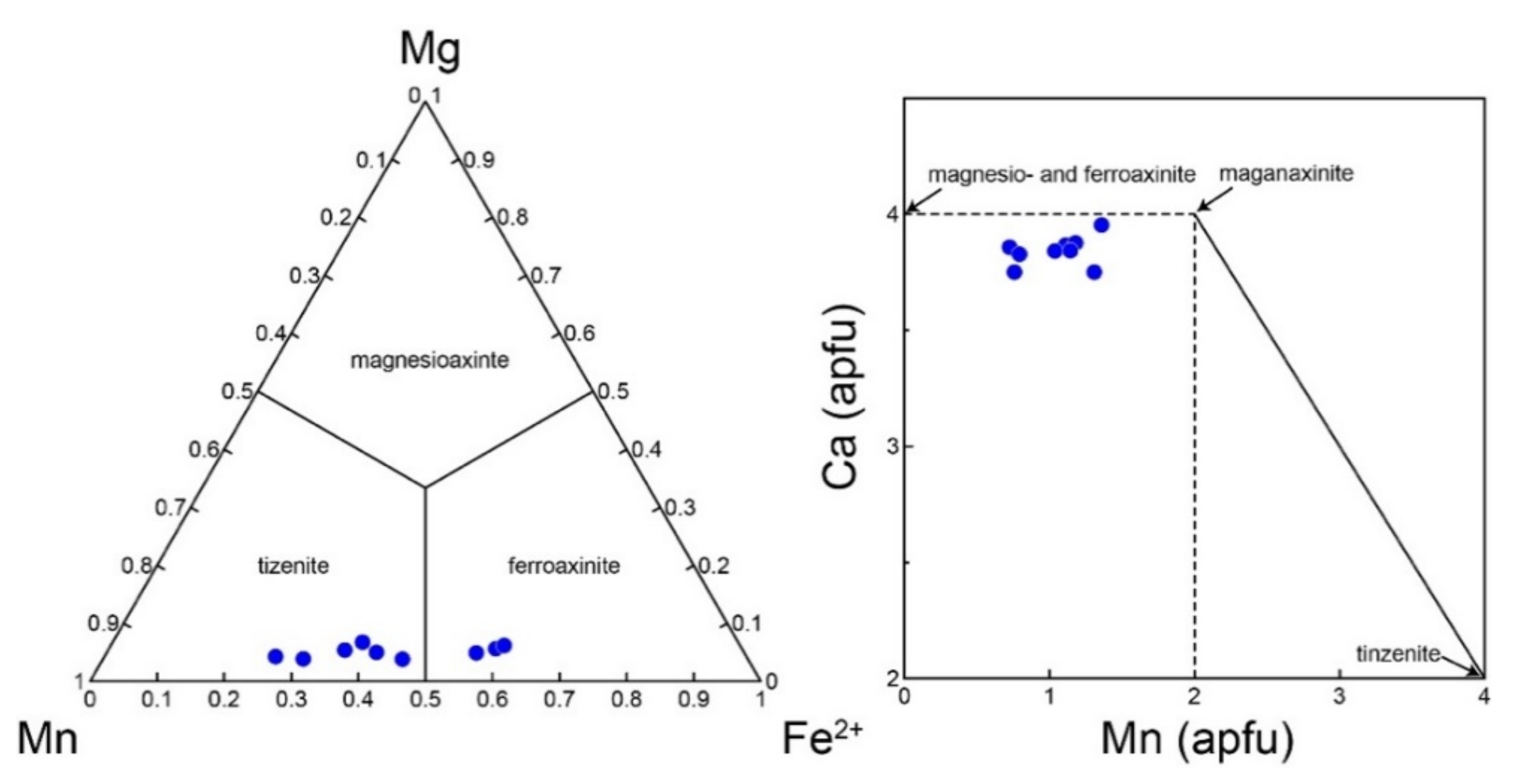
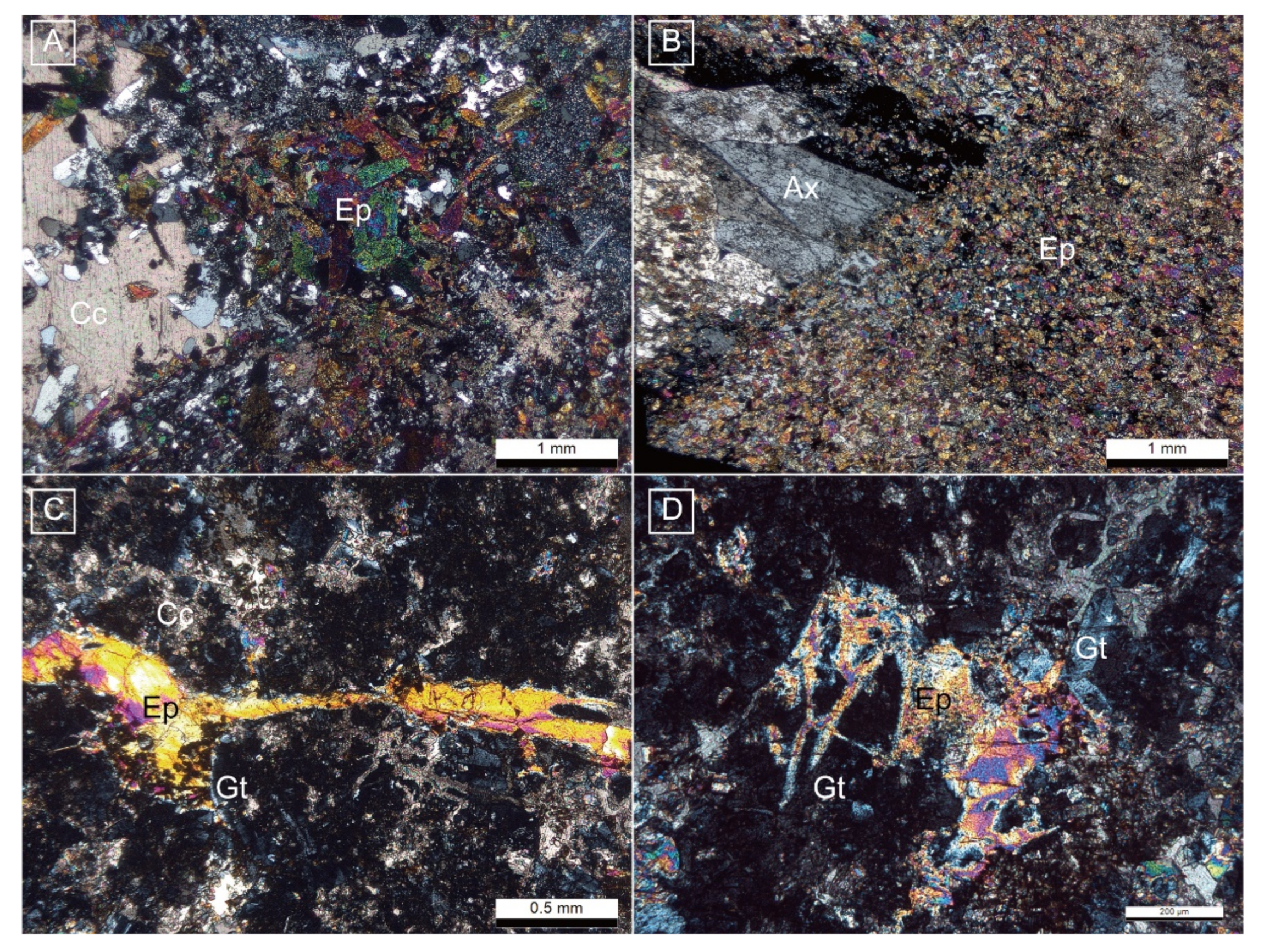
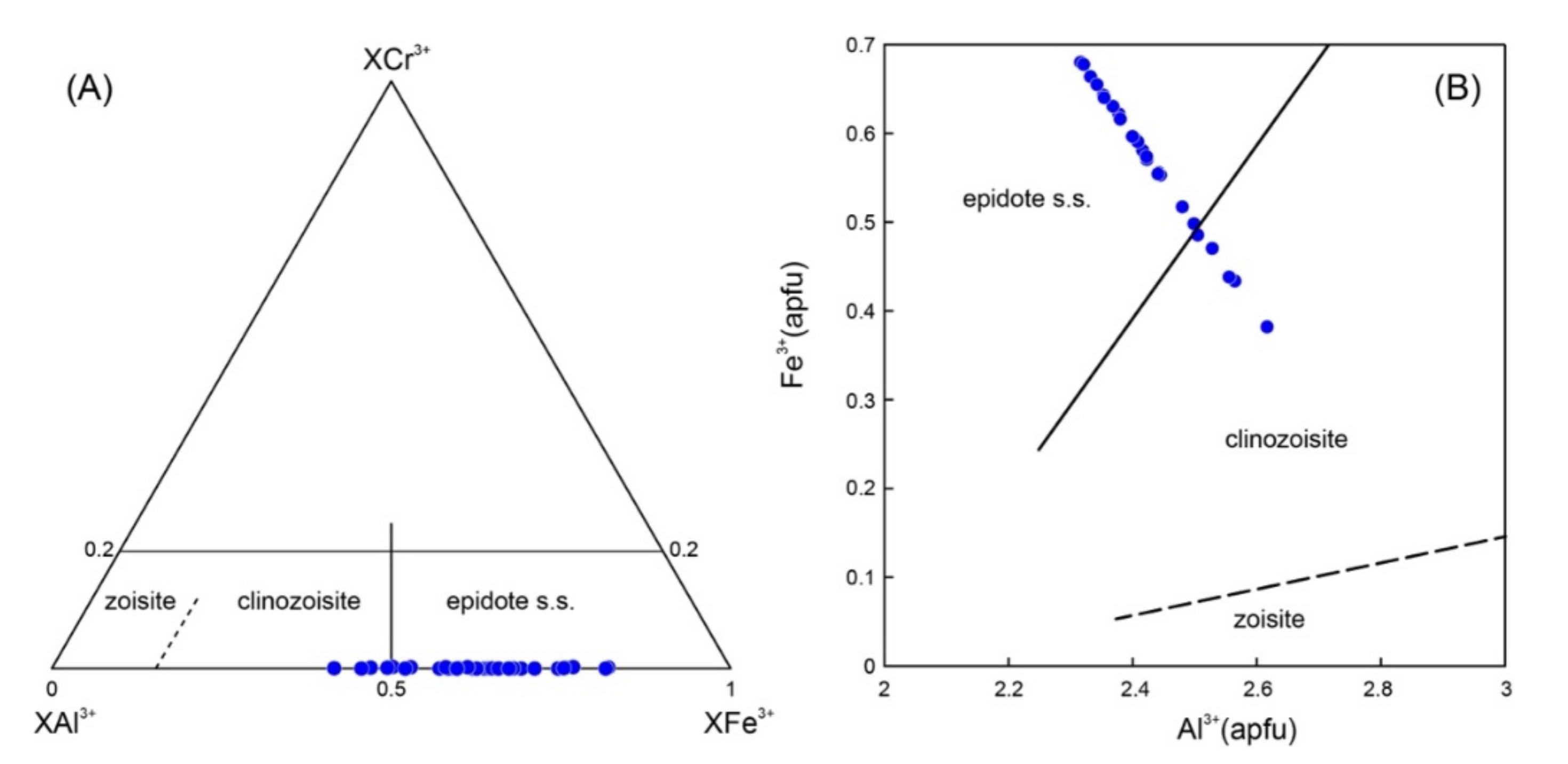

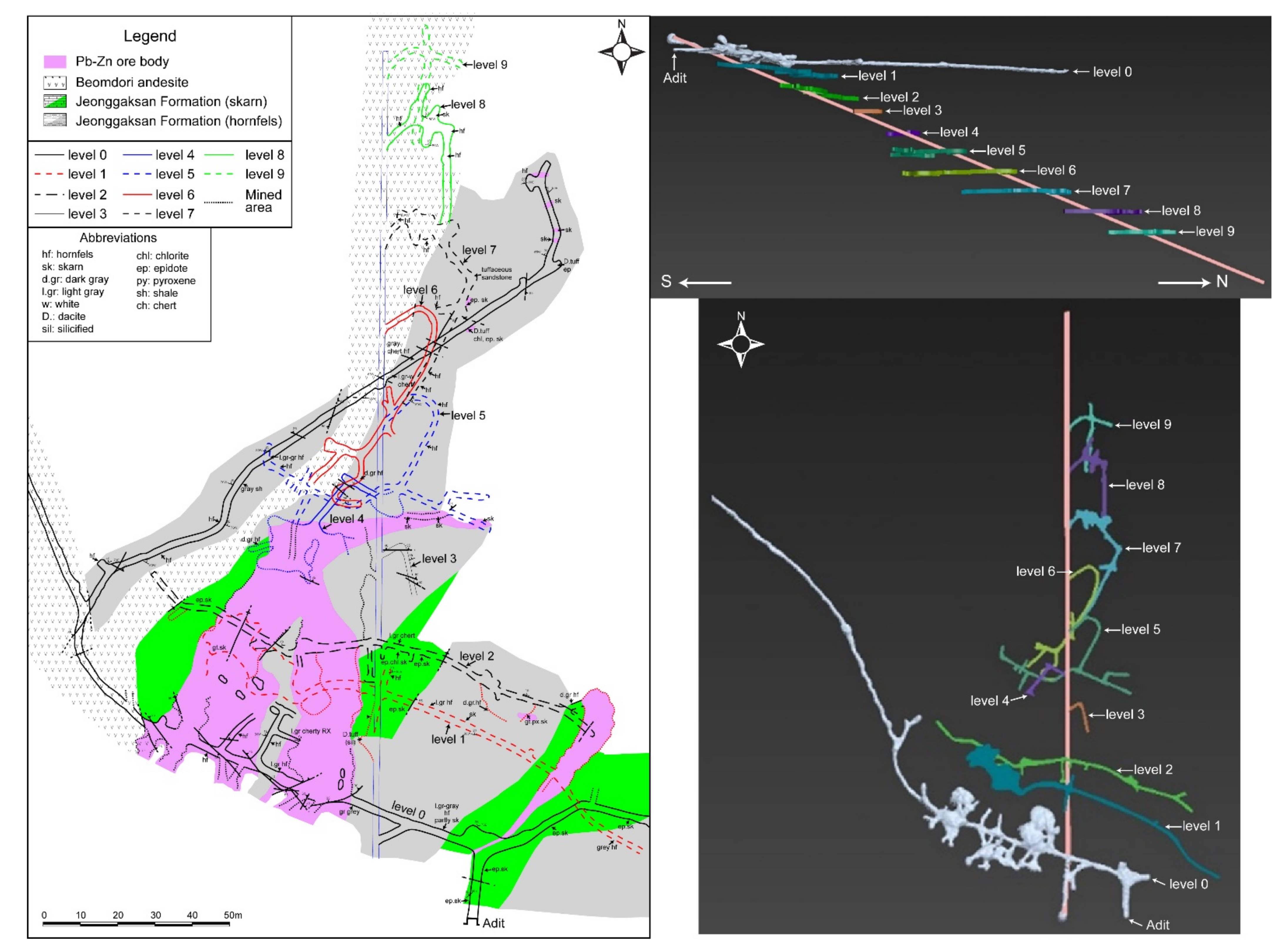
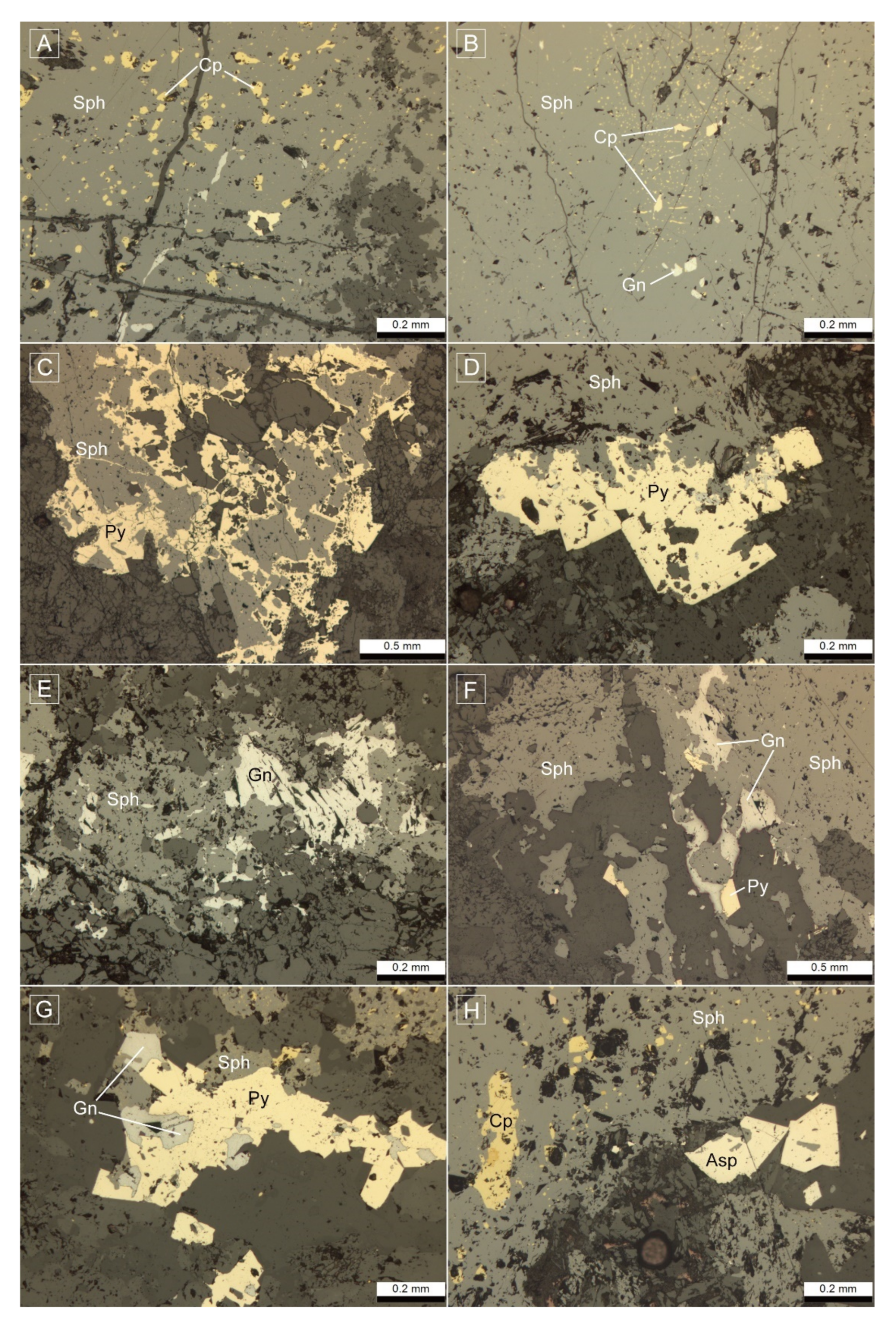

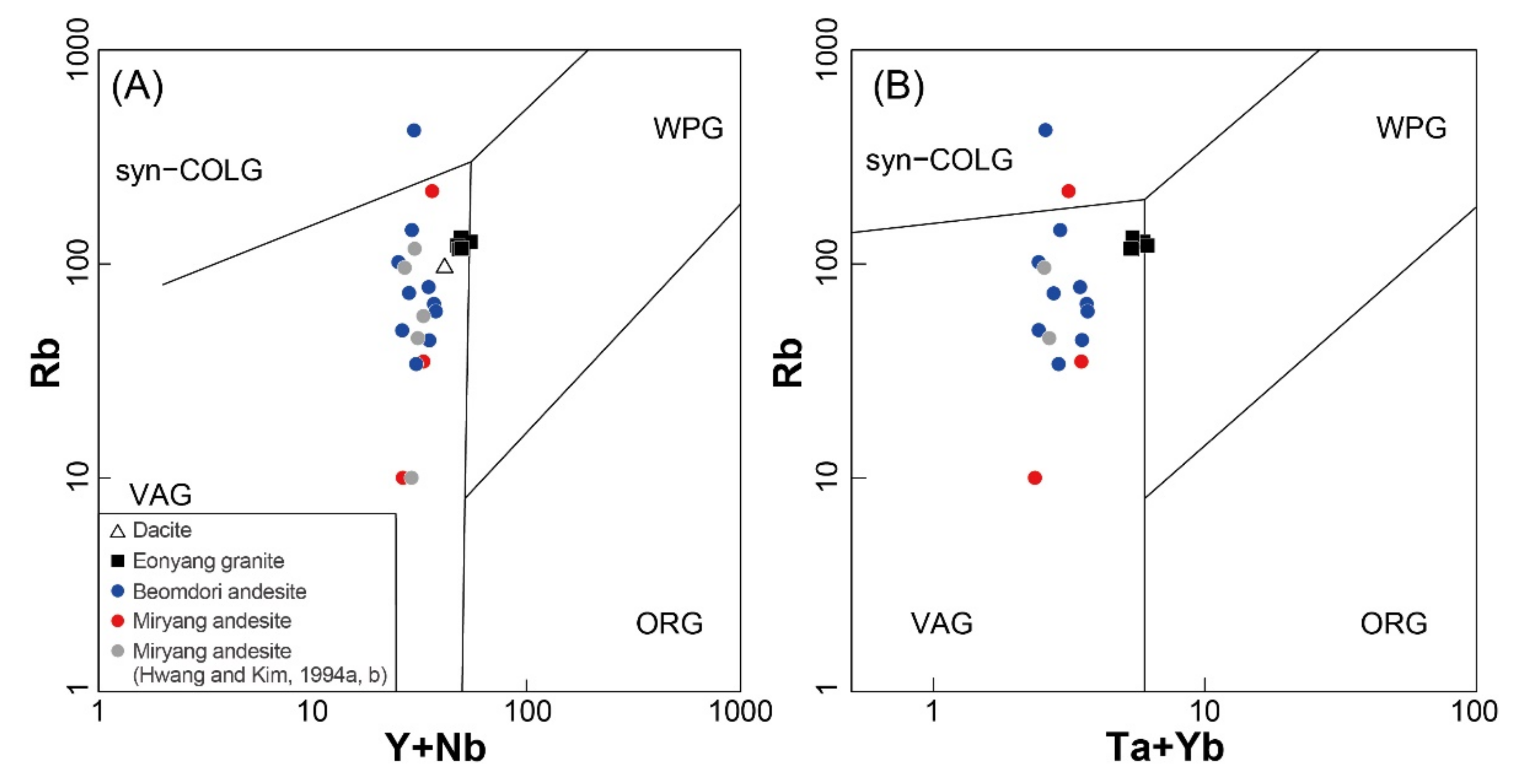
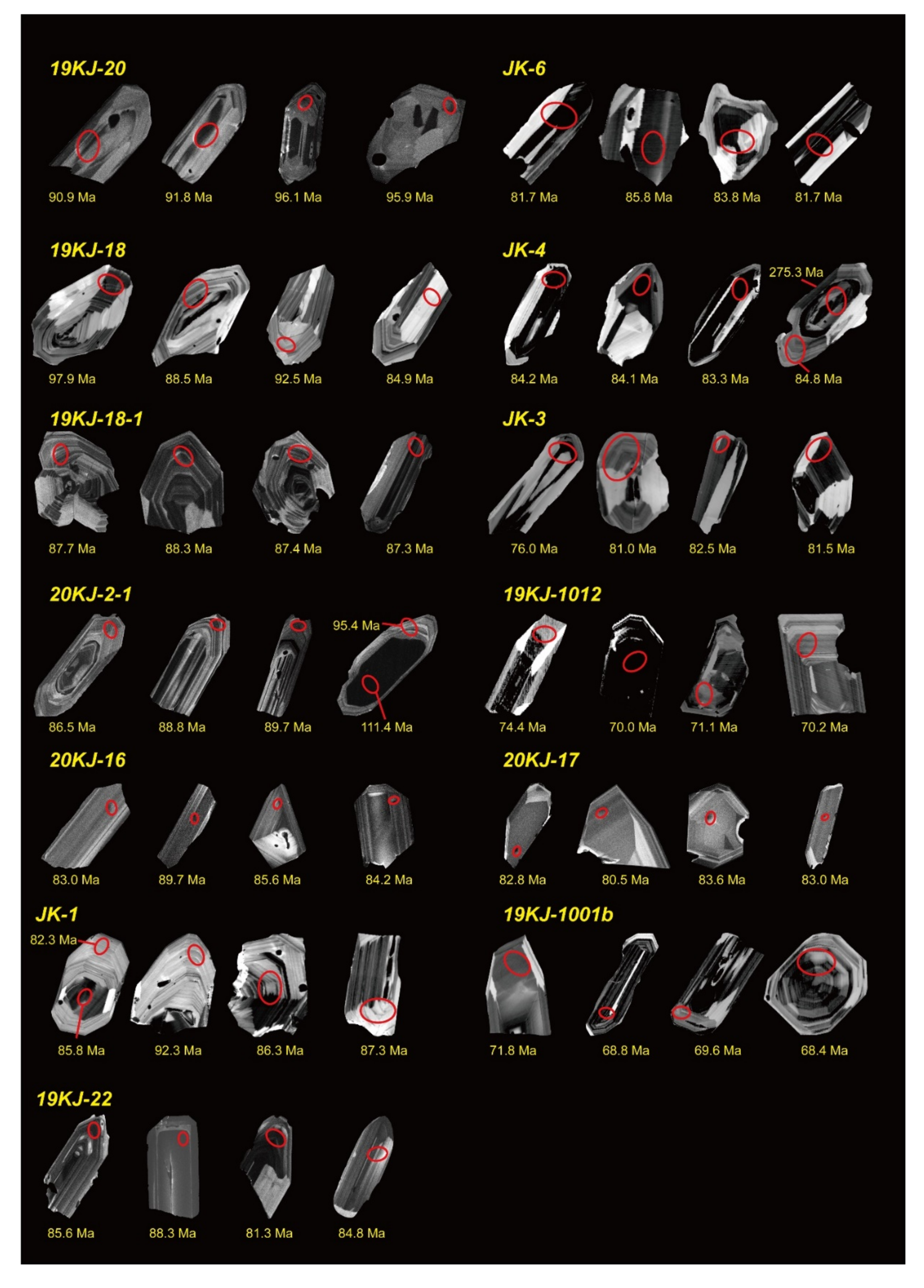
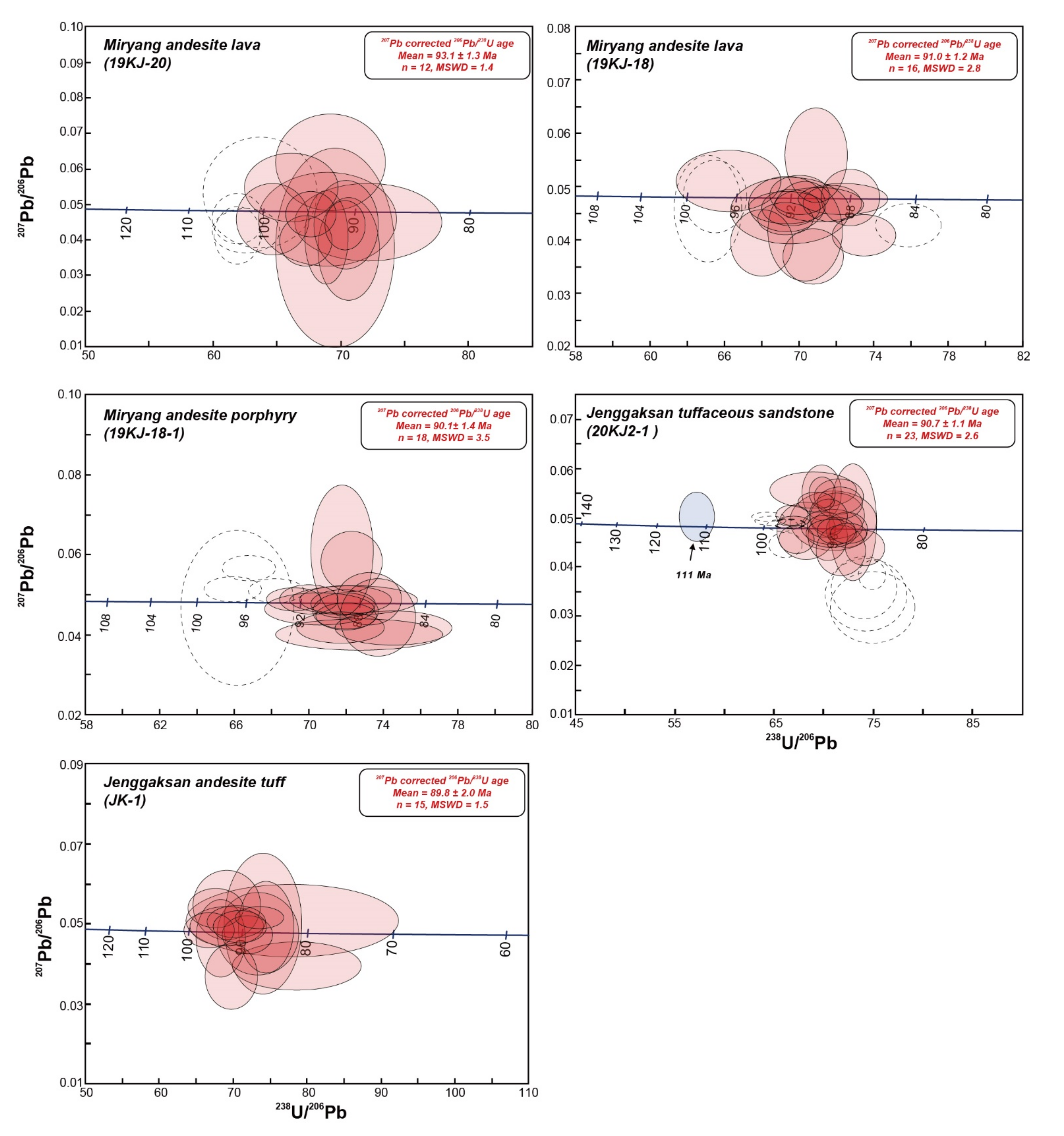

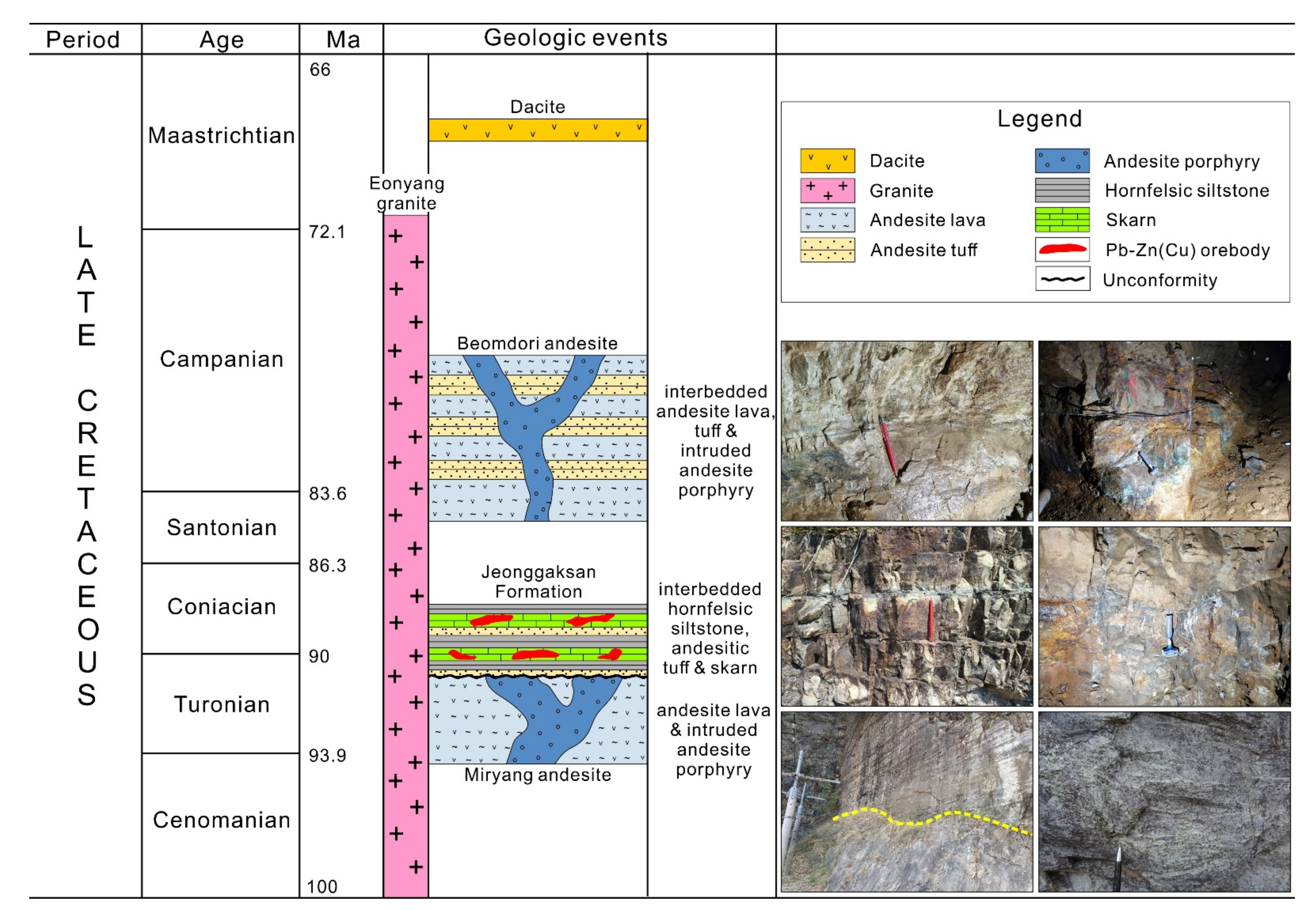

| Unit | Sample No. | B | Pb | Zn | Unit | Sample No. | B | Pb | Zn |
|---|---|---|---|---|---|---|---|---|---|
| Jeonggaksan andesite | 20KJ-2-1 | 11.4 | 35 | 50 | Argillic altered rocks (Beomdori andesite-hosted) | 20KJ-8 | 0.9 | 23 | n.d. |
| 20KJ-2-2 | 82.6 | 13 | 40 | 20KJ-9 | 5.1 | 37 | n.d. | ||
| Andesitic rocks (Miryang andesite) | 19KJ18-1 | 122 | 85 | 360 | 20KJ-10-1 | 34.3 | 48 | n.d. | |
| 210105-1-1 | 370 | 75 | 30 | 20KJ-10-2 | 10.5 | 13 | n.d. | ||
| 210105-2-1 | 160 | 120 | 40 | 20KJ-10-3 | 27.7 | 65 | n.d. | ||
| 210105-2-2 | 28.3 | n.d. | n.d. | 20KJ-10-4 | 44.3 | 20 | 60 | ||
| 210105-3 | 123 | 223 | 460 | 20KJ-10-5 | 33 | 14 | n.d. | ||
| 210105-4 | 87 | 105 | 660 | Fine-grained granodiorite | 20KJ-16 | 6.9 | 11 | 80 | |
| 210105-5 | 54.5 | 119 | 670 | 20KJ-17 | 5.3 | 10 | 80 | ||
| Andesitic rocks (Beomdori andesite) | 20KJ-3 | 9.3 | 7 | 80 | Granitic rocks (Eonyang granite) | 19KJ-1008 | 5.4 | 12 | 40 |
| 20KJ-4a | 6.4 | 13 | 100 | 19KJ-1009 | 1 | 17 | 60 | ||
| 20KJ-4b | 12.3 | 24 | 110 | 19KJ-1010 | 0.6 | 11 | 50 | ||
| 20KJ-5 | 13.5 | 24 | 180 | 19KJ-1011 | 2.8 | 14 | 60 | ||
| 20KJ-7 | 9.7 | 6 | 140 | 19KJ-1012 | 1.4 | 23 | 80 |
| Formation or Igneous Body | Sample Number | Rock Type | Dating Method | Age (Ma) | Reference |
|---|---|---|---|---|---|
| Dacite | 19KJ-1001 | dacite | SHRIMP | 68.6 ± 0.9 | This study |
| Eonyang granite | 19KJ-1012 | granite | 72.0 ± 1.0 | ||
| Fine-grained granodiorite | 20JK-16 | granodiorite | 82.8 ± 1.8 | ||
| 20JK-17 | granodiorite | 81.6 ± 0.4 | |||
| Beomdori andesite | JK-3 | andesitic tuff | 81.1 ± 1.1 | ||
| JK-4 | porphyritic andesite | 83.8 ± 1.3 | |||
| JK-6 | 83.8 ± 1.6 | ||||
| 19KJ-22 | 84.9 ± 0.9 | ||||
| 090615-8 | andesite | IMS-1280 | 78.4 ± 1.5 | [29] | |
| Jeonggaksan Formation | JK-1 | andesitic tuff | SHRIMP | 89.8 ± 2.0 | This study |
| 20KJ2-1 | tuffaceous sandstone | 90.7 ± 1.1 | |||
| 090616-15 | tuff | IMS-1280 | 88.7 ± 0.7 | [29] | |
| 090616-1 | andesite | 88.8 ± 1.0 | |||
| Miryang andesite | 19KJ-18-1 | andesite porphyry | SHRIMP | 90.1 ± 1.4 | This study |
| 19KJ-18 | andesite lava | 91.0 ± 1.2 | |||
| 19KJ-20 | andesite lava | 93.1 ± 1.3 | |||
| 090615-3 | andesite | IMS-1280 | 94.3 ± 2.0 | [29] |
Publisher’s Note: MDPI stays neutral with regard to jurisdictional claims in published maps and institutional affiliations. |
© 2021 by the authors. Licensee MDPI, Basel, Switzerland. This article is an open access article distributed under the terms and conditions of the Creative Commons Attribution (CC BY) license (https://creativecommons.org/licenses/by/4.0/).
Share and Cite
Kim, N.; Koh, S.-M.; You, B.-W.; Lee, B.H. Mineralogy, Geochemistry, and Age Constraints on the Axinite-Bearing Gukjeon Pb–Zn Skarn Deposit in the Miryang Area, South Korea. Minerals 2021, 11, 619. https://doi.org/10.3390/min11060619
Kim N, Koh S-M, You B-W, Lee BH. Mineralogy, Geochemistry, and Age Constraints on the Axinite-Bearing Gukjeon Pb–Zn Skarn Deposit in the Miryang Area, South Korea. Minerals. 2021; 11(6):619. https://doi.org/10.3390/min11060619
Chicago/Turabian StyleKim, Namhoon, Sang-Mo Koh, Byoung-Woon You, and Bum Han Lee. 2021. "Mineralogy, Geochemistry, and Age Constraints on the Axinite-Bearing Gukjeon Pb–Zn Skarn Deposit in the Miryang Area, South Korea" Minerals 11, no. 6: 619. https://doi.org/10.3390/min11060619
APA StyleKim, N., Koh, S.-M., You, B.-W., & Lee, B. H. (2021). Mineralogy, Geochemistry, and Age Constraints on the Axinite-Bearing Gukjeon Pb–Zn Skarn Deposit in the Miryang Area, South Korea. Minerals, 11(6), 619. https://doi.org/10.3390/min11060619







